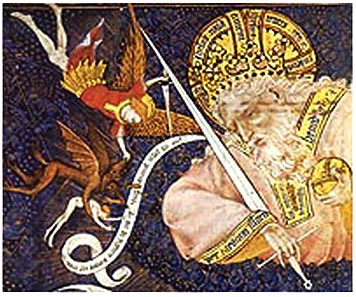 |
Symbolism
The Symbol of the Sword
in Today’s Defense of the Church
Atila Sinke Guimarães
When one considers the principle characteristics of the Conciliar Church, one see that among them tolerance stands out. The basis of ecumenism is the concept that one should have tolerance for the errors of the false religions. The basis of aggiornamento – that is, the adaptation of the Church to the modern world – is also the notion of tolerance in relation to the revolutionary principles represented by the modern world. One can safely say that tolerance is the foundation of the two principal initiatives of Vatican Council II and the reforms that were applied in the post-Conciliar period.

God the Father, wearing the symbols of an Emperor,
carries a sword while he judges a soul.
The Book of Hours of Rohan, 15th century |
Another important action of the New Church in the political-social ambit is its effort in favor of peace. Any war – by the fact of it being a war – is considered evil. This is expressed in the Encyclical Pacem in terris by John XXIII, as also in important excerpts of the conciliar document Gaudium et spes. I recall that on the visit he made to the Holy Land, Paul VI planned a trip to the Valley of Armageddon. The ladies and gentlemen here present certainly will remember that, according to many interpreters, the last battle of History will take place at The Valley of Armageddon. It would be the battle between Our Lord and the Anti-Christ, the battle of the final victory of Jesus Christ.
Paul VI, however, wanted to walk through the Valley of Armageddon crying out in Hebrew: “Shalom, shalom!” Or, that is to say, the Vicar of Christ wanted to go to the site of the last battle and express symbolically that there should not be another war.
Thus, tolerance is a keynote of the new religion that is being instilled by the followers of progressivism.

|
Symbolism | Religious | Home | Books | CDs | Search | Contact Us | Donate

© 2002- Tradition in Action, Inc. All Rights Reserved
|
 |
|